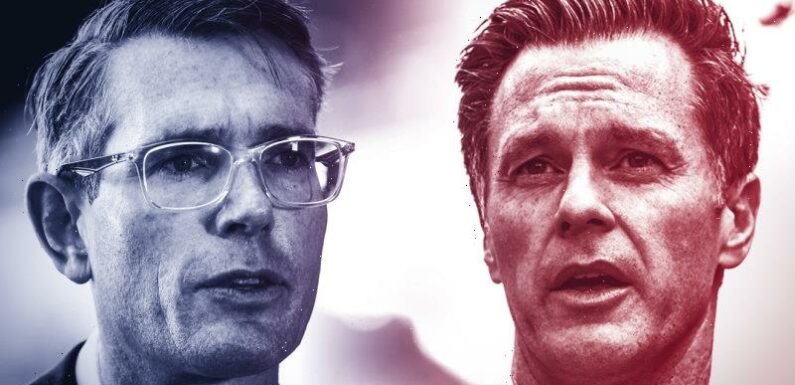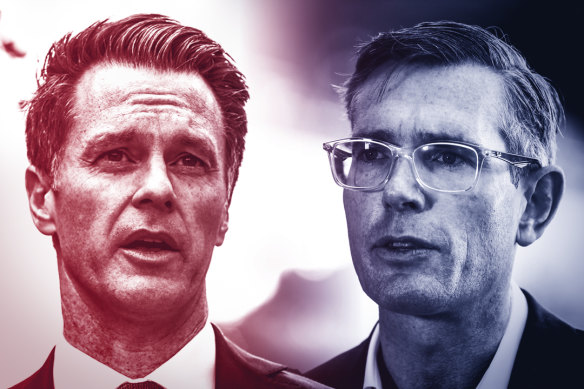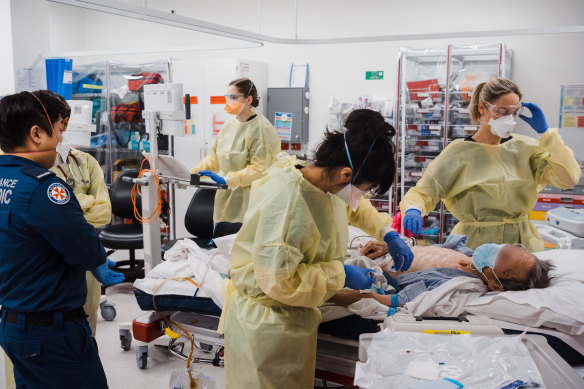
Who’s got their finger on the pulse of NSW’s economy and healthcare woes: Premier Dominic Perrottet or Opposition Leader Chris Minns?
We fact-check the key claims made by the two men vying for the NSW premiership when they went head-to-head in the first leaders’ debate on Thursday.
We fact-check the claims made by NSW Labor leader Chris Minns and Premier Dominic Perrottet during the first leaders’ debate ahead of the state election.Credit:The Sydney Morning Herald
Is NSW Australia’s fastest-growing economy or the second-slowest?
Perrottet says his state has “the fastest-growing economy” in the country at 3.75 per cent. Minns says we’re second-last. So, which is it?
Each side is drawing from different metrics.
The premier is leaning on NSW Treasury’s latest budget growth figures released on Tuesday and predicts the economy will expand by 3.75 per cent this financial year.
Compared with other state and territory forecasts from their most recent budget papers, NSW has the fastest growth forecast, followed by Victoria and Western Australia’s 3 per cent forecasts.
Minns is referring to an AAP fact-check published on February 3, which among other measures included the most recent gross state product per capita figures for the 2021-22 financial year, which shows NSW in second-last place.
Both measures have their shortcomings. The former is a forecast, and the latter is eight months old.
Is NSW’s hospital system in crisis, or is it the best in the country?
Can you see the sleight of hand here? Both claims can be true, but both leaders got a few key facts wrong.
Minns pummelled Perrottet over the state of NSW’s hospitals.
“We’ve got 100,000 people on the elective surgery waiting list including 4000 children.
We know that one in 10 people in NSW Emergency Departments [EDs] waits longer than 24 hours in an ED,” the Labor leader said.
Perrottet countered: “If you look at our emergency departments, they are the best in the country. We have the strongest health system anywhere in the country we saw during the pandemic … We had the lowest wait times are more and more patients were seen in terms of the elective surgery backlog.”
The premier blamed the crisis hitting general practice for the pressures on the state’s emergency departments.
Staff at Concord Repatriation Hospital work on a patient brought in through the emergency department.Credit:James Brickwood
“The issue is actually people across NSW and across the country not being able to see their GP. That is a national challenge that we’re dealing with right now,” Perrottet said.
Minns’ elective surgery and wait times claims stack up. We don’t know how many people are on the elective surgery wait list today, but according to the most recent NSW hospital performance data from the Bureau of Health Information (BHI), almost 99,985 were on elective surgery waiting lists at the end of September 2022, including 3898 children.
Some 18,000 of these patients had been waiting longer for their surgeries than clinically recommended guidelines.
It’s also true that patients are facing long ED wait times, even as fewer people turn up to hospital EDs compared with the same quarter in 2021 and pre-pandemic levels, the BHI data shows.
But Minns’ claim that one in 10 patients in NSW emergency departments waits longer than 24 hours in an ED is off the mark.
One in 10 patients who were “treated and admitted” – that is, their treatment started while they were in ED – spent longer than 22 hours and 5 minutes in the ED, which was the longest of any quarter since BHI began reporting in 2010.
But this figure does not include the patients who were treated and discharged, transferred to another hospital or left without being treated. Overall, the median time spent in EDs was 3 hours and 33 minutes, and one in 10 patients was still there 11 hours and 4 minutes after arriving.
Now to Perrottet’s GP claims. If the premier was suggesting that people with minor health problems are clogging up emergency departments because they can’t get a GP appointment that day, the data doesn’t back him up.
Opposition Leader Chris Minns and Premier Dominic Perrottet before the election debate at 2GB on Thursday.Credit:Dominic Lorrimer
People arriving at emergency departments are increasingly more acutely unwell and suffering from multiple and complex conditions requiring urgent hospital care.
Patients in the highest, most urgent triage categories account for the bulk of emergency department presentations and their numbers are rising.
Meanwhile, the latest BHI data from August to September 2021 shows the number of patients in non-urgent category – with ailments that could be treated in general practice – was the lowest it has been since reporting began a decade ago.
But the premier is right to highlight the cause-and-effect of a lack of access to primary care in the community which could prevent patients needing to be admitted to hospital down the track.
As Dr Clare Skinner, president of the Australasian College of Emergency Medicine says, the crisis facing emergency departments “is the result of decades of underfunding and under-resourcing primary care”.
“We’re seeing people with chronic and complex illnesses who have deteriorated to the point where they need a hospital admission because they haven’t been able, or can’t afford, to access that care in the community,” she said.
Perrottet’s decision to compare NSW hospitals’ performance with other Australian states and territories is a much more favourable dataset for the premier.
It is true that NSW’s emergency department wait times were the lowest in the country during COVID-19 and more patients were seen on time in NSW EDs than in any other state or territory, according to the Australian Institute of Health and Welfare’s ED performance report for 2021-2022.
This was no mean feat. NSW’s emergency departments had more than 3 million presentations in 2021-22, a massive patient load compared to Queensland’s 1.87 million and Victoria’s 1.86 million.
AIHW data also confirmed Perrottet’s claim that NSW performed more elective surgeries than any other jurisdiction (182,808 in 2021-22).
But NSW was not the best elective surgery performer, coming second to Queensland regarding the proportion of patients who got their surgery within clinically recommended timeframes (82.7 per cent versus 84.5 per cent respectively).
Are burnt-out healthcare workers leaving NSW hospitals in droves?
Minns accused Perrottet of failing to listen to frontline healthcare workers amid a deepening hospital workforce crisis.
“Thirty resignations from the emergency department from nurses at Blacktown [and] 30 resignations at Westmead,” the opposition leader said.
That figure – 60 nurse resignations across two hospital EDs in western Sydney – comes from members of the NSW Nurses and Midwives Association (NSWNMA) who kept a running tally of their colleagues’ resignations.
On Thursday, a spokeswoman for the association said 27 ED nurses had resigned from Blacktown in the past 12 months, and 35 at Westmead ED between January and November 2022.
That number does not include nurses who have reduced their hours, the spokeswoman said.
Western Sydney Local Health District, which oversees the two hospitals, said Minns’ resignations claim was inaccurate but did not disclose how many resign and the movement of ED nurses at the two hospitals “followed normal attrition rates”.
In a statement, a spokeswoman did not disclose how many nurses had resigned, but said the movement of ED nurses at the two hospitals had “followed normal attrition rates” and that the health district had a record number of nursing and midwifery graduates starting this year.
Minns also claimed, “70 per cent of health workers in NSW are looking to move to other jurisdictions to work in their health services rather than here in NSW”.
Take this claim with a grain of salt. It is based on a survey commissioned by Unions NSW of 2893 public sector workers, which asked if respondents “have or are considering” moving and working in the public sector in other states.
Seventy-one per cent of healthcare worker respondents agreed with this statement, but we don’t know how many survey respondents were healthcare workers, as opposed to teachers, firefighters and bus drivers.
It’s a small sample size to make such a devastating and broad claim about workforce of more than 122,500 full-time equivalent healthcare professionals.
That said, we know from our own reporting that healthcare workers are reporting high levels of burn-out, and a staffing and recruitment crisis caused by staffing shortages, under resourcing and the public sector wage cap is at risk of compromising patient care.
With Matt Wade
The Morning Edition newsletter is our guide to the day’s most important and interesting stories, analysis and insights. Sign up here.
Most Viewed in National
From our partners
Source: Read Full Article


